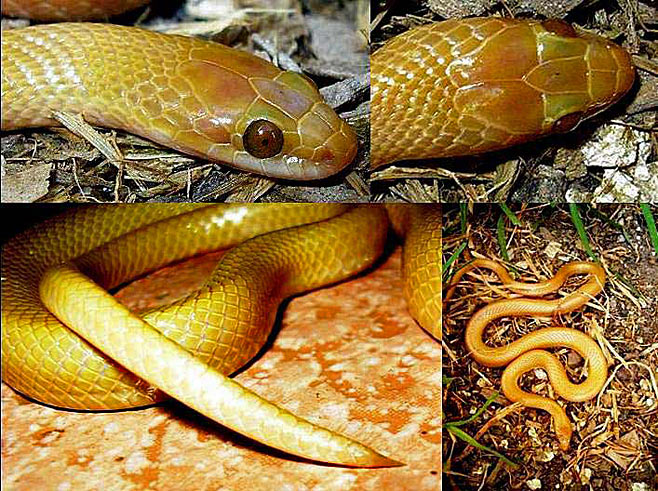|
Lamprophis fuscus (Yellow-bellied house snake)
Geelpenshuisslang [Afrikaans]
Life >
Eukaryotes
>
Opisthokonta >
Metazoa
(animals) > Bilateria > Deuterostomia >
Chordata >
Craniata > Vertebrata (vertebrates) > Gnathostomata (jawed vertebrates) >
Teleostomi (teleost fish) > Osteichthyes (bony fish) > Class:
Sarcopterygii (lobe-finned fish) > Stegocephalia (terrestrial vertebrates) >
Tetrapoda
(four-legged vertebrates) > Reptiliomorpha > Amniota >
Reptilia (reptiles) >
Romeriida > Diapsida > Lepidosauromorpha > Lepidosauria >
Squamata > Serpentes
(snakes) > Family: Colubridae > Subfamily:
Boodontinae > Genus:
Lamprophis
 |
|
Lamprophis fuscus (Yellow-bellied house
snake), Western Cape [M. Witberg and R. van Zyl ©,
from
SARCA Virtual
Museum] |
Identification
The Yellow-bellied house snake can be identified by olive
green or brown colour, yellow underside and bottom lip and its strictly nocturnal
lifestyle. It grows to an average length of 50 cm but may reach up to 75 cm.
Distribution and habitat
The distribution of this snake is restricted to 7 small
patches in the Western Cape, KwaZulu-Natal and Mpumalanga. Its preferred habitat is arid
savanna and grasslands.
Food
Feeds mostly on lizards but also
rodents
(particularly
shrews).
Predators, parasites and disease
Eaten by other snakes.
Reproduction
Oviparous (egg-laying), lays a small number of eggs in
summer.
Longevity
Has been known to live for 20 years in
captivity
Medical importance
Non-venomous and not dangerous to man and not likely to
bite.
Links
References
-
Broadley, D.G. 1983. FitzSimons' Snakes of Southern
Africa. Delta Books, Johannesburg.
-
Marais, J. 2004. A Complete Guide to Snakes of
Southern Africa. Struik Publishing, Cape Town.
|
